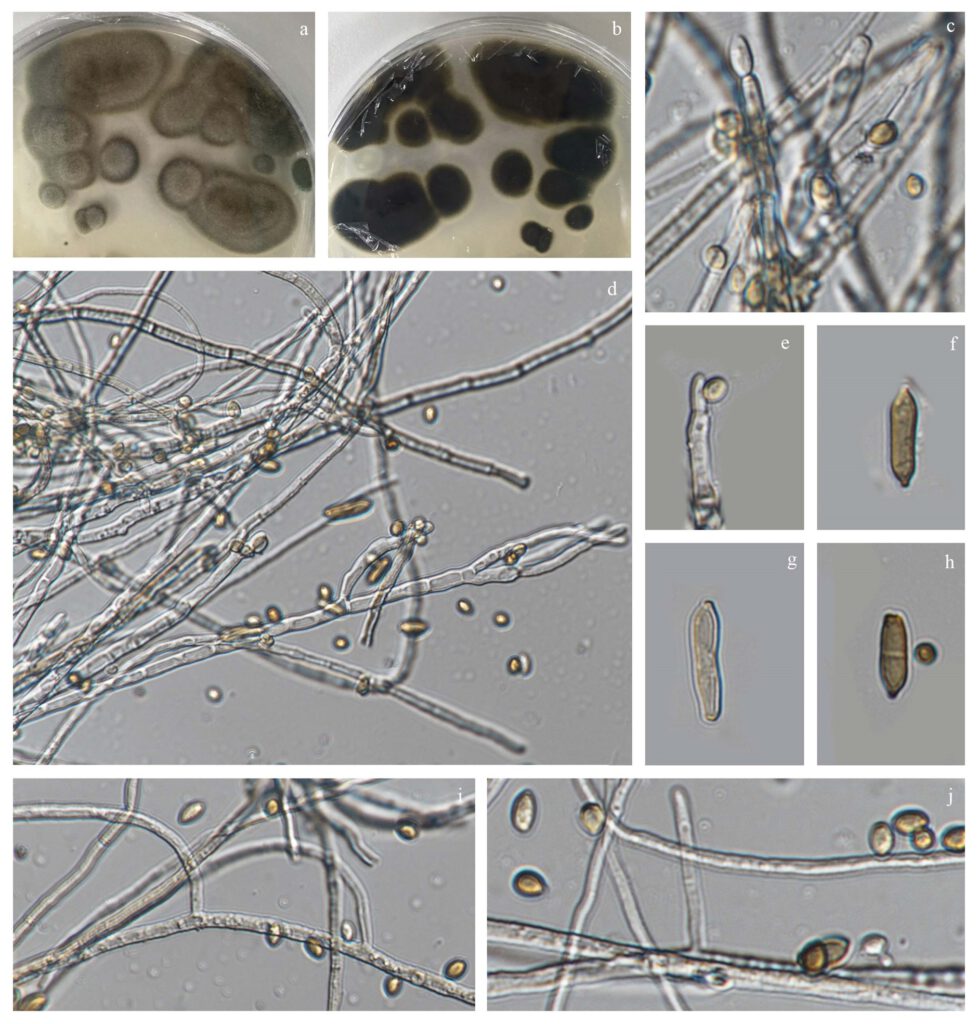Cladosporium xantochromaticum Sand.-Den., Gené & Cano [as ‘xantochromaticum’], in Sandoval-Denis, Gené, Sutton, Wiederhold, Cano-Lira & Guarro, Persoonia 36: 295 (2016), (Intanon49) (Fai)
MycoBank number: MB 817340; Index Fungorum number: IF 817340; Facesoffungi number: FoF 10750;
Saprobic on dead leaves of Rhododendron. Sexual morph: Undetermined. Asexual morph: Mycelium superficial and immersed, composed of septate, branched, 2.5–5 μm wide, subhyaline to pale brown, smooth to slightly roughened, thin-walled hyphae. Conidiophores erect, straight, cylindrical, non-nodulose, septate, simple or branched, up to 130 μm long, 2.5–4 μm wide, pale brown, smooth or sparingly verrucose with darkened and refractive scars. Conidiogenous cells terminal or intercalary, cylindrical, geniculate, 7–36 × 2–4 μm, with up to five apical loci of 1.5–2 μm diam, thickened and refractive. Ramoconidia aseptate, subcylindrical to cylindrical, 11–36 × 2–3 μm, pale brown, smooth-walled. Conidia forming branched chains with up to three conidia in the terminal unbranched part, pale brown, sparingly verrucose, with protuberant, somewhat darkened and refractive conidial hila; small terminal conidia aseptate, oval, 5–6.5 × 2–3.5 μm (av. (± SD) 5.9 (± 0.4) × 2.8 (± 0.4)); intercalary conidia aseptate, ellipsoidal to almost cylindrical with attenuated ends, 7–13 × 2.5–3 μm (av. (± SD) 10.6 (± 2.5) × 2.6 (± 0.2)); secondary ramoconidia 0–1-septate, ellipsoidal, 8.5–18 × 2–3 μm (av. (± SD) 14.3 (± 3.3) × 2.6 (± 0.5)).
Material examined – THAILAND, Chiang Mai Province, Doi Intanon, on dead leaves of Rhododendron, 12 October 2019, Napalai Chaiwan, Intanon49, MFLU 1***–***, living culture MFLUCC 12–****.
Host – Acacia mangium, Erythrophleum chlorostachys, Eucalyptus sp., Human, BAL , Musa sp., On Zea mays, Strelitzia sp. and dead leaves of Rhododendron (This study).
Distribution – South Carolina and Thailand (This study).
GenBank accession numbers – ITS: OM908935.
Notes – In the phylogenetic analysis, our isolate grouped with with Cladosporium xantochromaticum with medium support (64 % MLBS, Fig.***). A comparison of the phylogenetic tree indicates that our strain is Cladosporium xantochromaticum. Cladosporium xantochromaticum report by Cooke, Grevillea (1878) this species report in Zea mays from South Carolina. Lectotype NY 945791 (Designated by Heuchert, Braun & Schubert, Schlechtendalia 13: 1-78. 2005). pitype CBS H-20449 (Designated by Bensch, Groenewald, Dijksterhuis, Starink-Willemse, Andersen, Summerell, Shin, Dugan, Schroers, Braun & Crous, Stud. Mycol. 67: 79. 2010). Sandoval-Denis et al. 2015 upload the sequence in the NCBI. However, in our study we isolated the same species from Rhododendron sp.

Figure *** – Cladosporium xanthochromaticum (Intanon49, MFLU ***, herbarium). a–b Appearance of fungi on host substrate c–h Conidiophore i–k Conidia and ramoconidia Scale bars: b=10 μm, a=100 μm, c–f, i–k=20 μm, g–h=10 μm.
